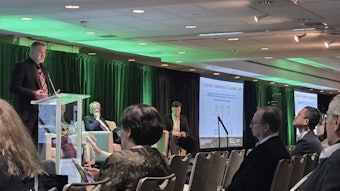
“The measure of success for this company is not the ability to make claims or justify to a legal group what I can and cannot say on a package, but rather to provide results the consumer can see from across the room.”—Rob Robillard
Two new product lines have stepped outside of the traditional beauty box and embraced a different approach to product development: the science behind it. For the companies that have created these lines, the science was developed at a place not traditionally associated with beauty: the Massachusetts Institute of Technology (MIT) in Cambridge.
Living Proof
Living Proof was created to bring a technological innovation to the beauty industry. That ideal extended to all areas of the company, and resulted in the unlikely partnering of a beauty industry veteran with a renowned scientist. Living Proof named 15-year beauty industry executive Rob Robillard chief executive officer, pairing him with Robert Langer, institute professor at MIT and founder of Langer Labs.
“The company was created to tackle big [beauty] problems. Everything created by the company would be composed of new materials. It had to be something you’ve never seen before; it would be patented, it would be proprietary and, most importantly, it would be designed to solve the problem at hand,” explains Robillard. “It’s also important to note that none of the scientists on the team came from the beauty industry. [The company founders] wanted everything to be fresh.”
Living Proof’s debut product line, No Frizz, was created to tackle the problem of frizzy hair. “When creating the product, the team took a very ‘Langer Lab’ approach, which is to figure out the root cause of the problem: why is it happening, is there a material way to fix it and what is the best way to fix it utilizing new materials and approaches,” Robillard explains.
No Frizz evolved out of the discovery of the polyfluoroester molecule by Langer and his team. The molecule, smaller than materials traditionally used for frizz control, adheres tightly to the hair to provide longer-lasting moisture resistance and rebalancing of the hair fiber’s interaction with the atmosphere, even after extreme humidity.
Living Proof’s introduction to the marketplace gained early momentum by winning Allure magazine’s 2008 Best of Beauty Award for the technology behind the No Frizz line, in addition to positive press in other consumer beauty magazines and beauty blogs. “Beauty editors and editors at large are huge fans of the product, and they started telling each other about it,” says Robillard. “The other thing that was helpful was that bloggers started carrying the message far and wide. Even before the product hit, bloggers and communities of women who tried the product started creating fan sites for the brand.” In addition to the buzz surrounding the product, Robillard credits a combination of high touch public relations efforts with a modern mix of retailers to carry the products.
“There’s been a lot more product outreach than I’ve ever done before, because we know we have a product that people will love,” says Robillard. “We wanted to work with QVC and Sephora because they are both successful, growing retailers. Company size is also important, because when you’re creating a new molecule like we did, we needed to go to channels where we were able to reach a lot of people. It was very important to launch to a broad audience.”
Part of that broad audience includes scientists both within and outside of the beauty industry, and reaching them with the company’s own scientists.
“The scientists [Langer et al.] are actively involved in the press,” says Robillard. “We do try to play up the science behind [the product line] and keeping the balance of information is important.”
The fact that Robillard makes an effort to respond to every e-mail sent to the company also helps him maintain a sense of balance. “I’ve never felt like I had more information about what is and isn’t working than I do now. I will continue to respond to every customer and post on the blog as long as I’m able.”
Face It
The Face It skin care line was created by Allison Gallo, an MIT graduate with a degree in chemical engineering. While earning her degree, Gallo considered how she could apply what she was learning toward launching her own line of products. “I went to MIT to learn more about how to apply technology and research to skin care,” she explains. “My motivation for the line was to encourage young people to take care of their skin early. I put the line together based on my research of what people really need to have healthy skin.”
Her products feature an encapsulated delivery system and ingredients she discovered to be most effective while doing her course work. “I think my background does give [the line] credibility; for me, it was a really important experience in terms of developing the products. But I also think it’s important to look at the fact that I’m going through [my 20s right now], so I understand what’s important in a skin care line,” she explains. To introduce Face It to the market, Gallo took her products directly to her target audience—embarking on a mini college tour, appearing at Fashion Week and spearheading online marketing efforts through the company’s Web site and via MySpace. “It was a soft launch. I wanted to keep it small so I could manage the sales and go from there,” she says. Currently, Face It products are only available through the Web site, but as the line grows, Gallo is looking for the best retail outlet to reach her target market. “I don’t mind keeping [the line] small, I just really want people to use the products and enjoy them,” she says.
MIT’s Future in Beauty
The presence of MIT in the beauty industry clearly increases the potential for innovation. “I’m surprised it hasn’t happened sooner,” says Gallo. “Now that the cosmetic industry has become more technical, people can see what MIT has to contribute.” Robillard adds, “Because we are successful, people will follow suit.” As for Living Proof and Face It, both companies are committed to the current product lines and will launch new products when they are ready.
“We’re not led by a marketing calendar, says Robillard. “When the next invention is ready, we’ll launch it.”
Gallo echoes the sentiments, noting, “I would like to expand the brand, but initially I want people to understand the current line. For me to develop a new product, it really needs to have a strong place in the line.”
Alexandra Voigt is a freelance writer for GCI magazine.










